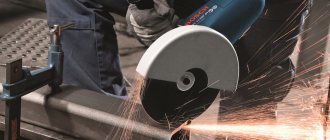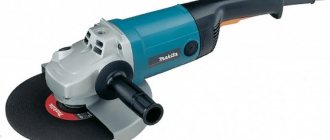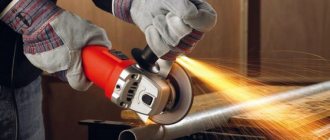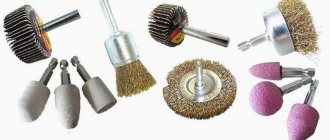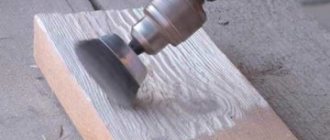Many homely owners have an angle grinder in their home arsenal - this is what people call an angle grinder. And so, when the need arises to work with wood: cut boards, cut down branches on trees or prepare firewood; and there is no corresponding electric saw at hand: circular, jigsaw, chain, etc.; some savvy craftsmen say to themselves: “So what?! After all, there is a Bulgarian! It’s quite possible to get by with it!” How right are such resourceful masters?.. This is exactly what our article is about.
Which tool to choose
The grinder is a very extensive range of tools of one class, called an angle grinder (angle grinder). The device can have enormous power and work with a disk of 230 millimeters or more. Or be distinguished by its compact size and modest abrasives of 115 mm.
The disadvantages of large and heavy tools are obvious: they are difficult to work for a long time. In addition, precise wood processing requires serious skills and experience. It is simply difficult for a novice master to control a massive and powerful angle grinder. However, if there is a large processing area or the need to remove a significant amount of material, such an angle grinder is very good.
A small angle grinder also has disadvantages. The ratio of the diameter of its disk to the dimensions of the body does not allow processing hard-to-reach places. In addition, it is difficult to select a large volume of material with such a tool due to low power and overheating.
Many craftsmen prefer angle grinders with a disc diameter of 125 mm when working with wood. This is explained quite simply:
- In this class, grinders are presented in a wide range of operating capacities;
- it’s easy to choose a tool with comfortable dimensions and weight;
- There are many attachments and devices on the market designed for a standard 125 mm disc mounting hole.
In addition, a medium-power angle grinder provides relative safety for beginners. It will not make you get tired quickly, will allow you to more accurately control your movement, and will reduce the likelihood of defects on valuable parts.
Manual way to sand a wooden surface
In the absence of a special tool, grinding can be done by manually processing the surface. This requires only a special block, as well as sandpaper with a grain size suitable for the specific type of work. Among the features of this process, we note the following points:
- The design has a special fastening element, which ensures the fastening of sandpaper.
- Coarse sandpaper can be used to sand a product with a high roughness. This is due to the fact that small ones wear out quickly. Grinding should be carried out in several stages, due to which a high level of smoothness is achieved.
- Manual grinding is often carried out when the product has a small area.
- When using bars of various sizes and shapes, complex products can be processed.
What kind of circles are there for cutting wood?
Despite the dangers of using an angle grinder for cutting wood, tool manufacturers still produce saw blades for it.
Circular saws
The photo below shows a “dangerous” saw blade for an angle grinder, although its diameter corresponds to the protective casing of a grinder with a maximum working tool of 180 mm. There are tipped saws with smaller diameters.
In the next photo you can see a less dangerous version of a circular saw. It provides protection against jamming, and is implemented by slightly moving the teeth in different directions.
Chainsaws
A saw blade made using a chainsaw chain reduces the risk of injury if the tool jams. This attachment is designed in such a way that the chain attached to the inner disk (base) has a non-fixed fit.
If the chain gets stuck in the material being processed, the base continues to rotate and the tool does not tear out of your hands.
These chain discs for grinders have many modifications, and with their help you can trim branches in the garden, and can also be used for rough cutting of thin boards.
In addition to cutting, the chain disk can also be used as a peeling disk, for example, for removing bark, as well as for cutting cups in logs and modeling.
Saws with few teeth
Also, for grinders, in order to increase the safety of working with wood, tool manufacturers produce cutting discs with a small number of teeth.
Discs of small diameter can have 3 teeth, and large ones - 4, as shown in the following photo.
These grinder blades are excellent at cutting wood both along the grain and across it. In addition, with the help of a saw wheel you can cut grooves, make various cuts and tenons in the workpiece. But when working with an angle grinder, you should adhere to one rule: you need to install a cutting disc on the grinder of the same diameter for which it is designed by the manufacturer, that is, do not exceed its dimensions. Circles of smaller diameter can be installed.
Tungsten carbide discs
Tungsten carbide discs for angle grinders appeared on sale not so long ago and made a kind of revolution in the field of woodworking.
This universal disc has no teeth. Instead of the latter, segments are located around the circumference of the nozzle. The cutting disc is similar in appearance to a diamond wheel for cutting concrete. With the help of a tungsten carbide wheel for an angle grinder, you can very easily saw wood of any hardness and viscosity. In addition, he is not afraid of nails, screws and other metal inclusions that may be in the workpiece on his way.
This is the safest wood saw blade for an angle grinder.
Its price on the Internet is about 700 rubles. But if you consider the possible consequences of using circular saws, then this is a low price to pay for safety.
Selecting a drive by function
To choose the right disc, first of all, you need to decide what material to work with.
Can be used:
- Thin blades (1-1.6 mm) are best suited for cutting thin sheet metals, such as car bodies. When working with thicker corners, they can cut faster, but the risk of blade damage increases significantly. In this case, it is safer to use thicker discs.
- Hard - most often used for active processing (cleaning) of welds after welding and gluing metal surfaces before welding. They are used to remove (cut out) fasteners and protrusions on metal. They are also used in cases where the metal surface must be cleaned of rust or old paint.
- Elastic - mainly used as an alternative to metal brushes. They perfectly clean even curved metal surfaces from outdated paint and other similar coatings.
- Coarse - used for grinding metal and wood. Even the smallest welds can be smoothed out with large (largest grain) discs, but are mainly used for finer work. They remove faded top layers of wood surfaces, polish wood beams, rust and worn paint from metal.
- Abrasive - for processing concrete, diamond discs are slightly smaller, but they also have a shorter service life. Their use is justified only when it is necessary to perform a small one-time job.
- Diamond blades are used for cutting various products made of concrete and stone (paving slabs, steps, curbs, facing stones), as well as all types of bricks.
Turbo diamond discs (both regular and wave) are best suited for working with reinforced concrete and stone materials. When choosing, keep in mind that a turbo will provide a cleaner cut than a diamond wheel.
If the appliance has an outer diameter of only 125mm and the grinder is designed for 115mm, it cannot be installed for the following reasons:
- Firstly, the discrepancy between the revolutions of the tool itself and the circle is dangerous for the user.
- Secondly, as it heats up and expands, the disc can get stuck, causing it to jerk.
Wood sanding attachments
For wood processing, in addition to cutting wheels, there are attachments specially designed for installation on angle grinders, with which you can peel, grind, brush and mill wooden surfaces.
Peeling attachments
If you need to remove a layer of paint or other coating from a wooden surface, you can install a sanding attachment on the grinder. There are a large number of different attachments for grinding work available on the market. They differ in shape, design, and types of work that can be performed with this tool.
The photo below shows disk attachments with spikes or chips, with which you can easily remove the top layer of wood, grind down the end of the board, etc.
The next cutter, due to the fact that the tenons on it are located on a flat plane, allows you to level various wooden surfaces. For example, if 2 boards on the floor at the end joint are at different heights. Using this attachment, the defect is easily eliminated, and the boards are joined in the same plane.
There are also stripping attachments made of twisted wire. They can be made in the form of a metal cup with a wire inserted into it.
Or in the form of a disk with turns of wire clamped in its central part.
These brushes are used if you need to quickly remove old paint from a wooden surface or rust and paint from metal.
The next photo shows a brush with a smaller diameter wire, and it is used for finer roughing work on wood and metal.
In addition to cleaning, this brush is often used for brushing wood, that is, giving it an aging effect. If this effect needs to be used on large surfaces, in the professional field, then for brushing it is better to use special hand-held machines with wide brushes.
Grinding and polishing attachments
For grinding various surfaces, including wood, there is a special attachment for angle grinders on sale, consisting of a metal base, onto which an emery grinding wheel is attached with Velcro. The attachment is screwed onto the angle grinder shaft and tightened with an open-end wrench.
It is often equipped with an adapter for mounting in a drill chuck or drilling machine.
A grinding wheel is not used for polishing surfaces. Instead, felt discs are installed on the nozzle, which are secured with Velcro.
A flap sanding wheel is also often used for sanding wooden surfaces. It is called so because it consists of many petals fixed on its plane, made of sandpaper. The grain size of the latter can be selected based on the requirements for the surface being processed. For rough sanding, coarse-grain sandpaper is suitable, and for finishing sanding, vice versa.
The better way to sand wood - with a grinder or a sander - depends on what you are going to prepare the wooden surface for . If you are applying regular paint, you can use a grinding wheel. If for varnishing, then a grinding wheel mounted on an angle grinder cannot be used, since it will produce small radial scratches on the surface of the wood, which will clearly appear after applying the varnish. In this case, for grinding, use a longitudinal belt sander (the sanding belt moves longitudinally) or a vibration sander, where the same sanding wheels are used.
Flat Blade Disc
A disc with several blades protruding from the side can be considered as an alternative to a plane. It is intended primarily for removing material on a plane. This attachment is indispensable when logging; it allows you to very quickly and efficiently remove bark from unedged boards or logs. It is also convenient to process convex or form concave surfaces.
Doing such work with a plane is very difficult and time consuming. In addition to its obvious usefulness, the disk made of high-quality steel has a good service life. And dull blades can be sharpened without the use of special tools.
Cutting end discs
End discs, which are also called cutting, milling, sawing, offer processing of material with a normal load character for an angle grinder. That is, the nozzle rotates in the same way as an abrasive wheel, with the same directions of emerging forces and the mechanics of tool control.
These discs have a very important feature for beginners. The radial speed of the cutting edges is high. Therefore, when cutting grooves and sawing material, sudden load surges are possible. For example, due to its uneven density. The grinder can be torn out of your hands; there are cases where the disc is displaced with a blow due to a change in the nature and area of treatment. However, in the hands of a master, this relatively dangerous class of cutting discs allows you to perform many operations.
- Wheeled. It is made in the form of a separate product or an attachment to a regular abrasive. It has a flat end with teeth. The attachment is used both for milling grooves and for grinding their bottom and edges.
- Serrated studded. It is made in the format of a saw blade with teeth, has one row of protrusions on their side parts. The nozzle is designed to form a shallow groove. Side teeth prevent deformation and reduce the risk of strong jerks during operation. They also allow the craftsman to move perpendicular to the groove line, widening it.
- Toothed plane. The difference from the previous product is that the teeth are located on almost the entire lateral plane of the nozzle. The attachment can be used when processing a flat surface, forming rectangular grooves of considerable depth, and cutting thick workpieces.
It is simply impossible to list all the types of attachments, adapters and devices that can be installed on the angle grinder shaft. They allow you to significantly increase the functionality of your angle grinder. Having one tool in the workshop, the master can easily perform a large number of operations. It is not surprising that discs and attachments for angle grinders are very popular and more and more new options for devices are being developed.
Choosing the right device
First you need to decide on the tool (grinder - the correct name is a chain angle grinder) with which you plan to cut the wood. It is known that discs are made to standard grinder sizes. The smallest diameter is 115 mm, but this tool is used in rare cases. A wide range of power tools on the market are designed to facilitate various types of manual labor. If specialized equipment is simply necessary when working in the professional sphere, then in everyday life it is not always rational to spend money on expensive hand tools.
To operate the machine with wood, you need a special drive . Abrasive, diamond, and carbide wheels are absolutely contraindicated for cutting. This will not help cope with the task, but rather will lead to destruction or overheating of the device.
When choosing woodworking universal accessories, you should know that there are not only cutting discs, but also grinding wheels. To clean the wood, use a circular saw blade. The working surface of such a device consists of several layers of sandpaper, which has varying degrees of roughness. The lower the roughness, the softer the grinding. Flap wheels allow for polishing that varies depending on the level of detail.
Grinding wheels and a milling cutter for an angle grinder must be of high quality, which affects not only the quality of the work performed, but also the safety of the technician. Processing wet wood is prohibited, as the result of such manipulations can be unpredictable.
For roughing operations, which are often used as initial processing, special cleaning agents are used. They are necessary in order to remove a layer of paint from a painted surface.
The dangers of using an angle grinder with wood
The only operations with wood that can be performed with an angle grinder (angle grinder) without danger are grinding and roughing, and then using special attachments. Of course, you can cut wood, but it is very dangerous. The Internet is full of shocking photos showing what can happen when using an angle grinder as a cutting tool for wood.
The main arguments that can be made against using an angle grinder for sawing are as follows.
- This machine is not designed for sawing wood.
- Since wood has a viscous and soft structure, the saw blade can jam in it. As a result, the grinder is often torn out of the hands, and it flies in an unpredictable direction (in the leg, along the arms, in the stomach, etc.), causing deep wounds or amputation of fingers. Even fatal cases have been reported.
- When cutting wood, the saw blade heats up very quickly, causing it to begin to lose strength. The slightest misalignment or excessive pressure may cause it to fly apart. Since the spindle speed of an angle grinder is high, tool fragments fly away at the speed of shrapnel and penetrate deeply under a person’s skin. The user will be lucky if the fragments do not fly into the head or eyes.
- Despite the dangers of using saw blades with teeth, some angle grinder users ignore this fact and continue to install compass disks with large teeth or improved with carbide tips. If, when cutting wood, a hard knot or nail residue gets caught in it, the tooth or solder breaks off, gets caught by the next saw tooth and is thrown out at the speed of a bullet. One can only guess about the consequences.
- Ignoring all the warnings, users of grinders install a circular saw on the machine with a larger diameter than the protective casing. This is the most dangerous option for using an angle grinder.
Based on the above, you can cut wood with an angle grinder only at your own peril and risk, and only if this is a single or infrequent operation.
If you have to cut wood constantly, it is better to purchase a special machine for this purpose, or use a jigsaw. In extreme cases, the grinder can be used as a drive and made into a circular saw, securing the device rigidly to the frame.
Review of prices for popular models
The cost of products depends on the place of their sale, technical characteristics and brand of the manufacturer. This section of the article presents several models, on the basis of which one can get an idea of the order of the numbers that determine the cost of one or another type of similar product.
"GRAFF Speedcutter"
The GRAFF Speedcutter disc is a model with a small number of teeth
The disc is designed for sawing wood and plywood, laminate and board materials (fibreboard, chipboard). The model is equipped with three teeth.
| Disk type | Outer diameter, mm | Thickness, mm | Weight, kg |
| Cut-off | 115 | 3,8 | 0,12 |
Review of the “GRAFF Speedcutter” model:
More details on Otzovik: https://otzovik.com/review_6165824.html
GRAFF Speedcutter
"GREATFLEX 71-125120"
This petal-type model is made on a fabric basis using abrasive materials
GREATFLEX 71-125120 consists of 72 petals located at an angle of 10˚ to the working plane of the disk, which increases the efficiency of use of the product.
| Disk type | Outer diameter, mm | Grain | Weight, kg |
| Grinding (flap) | 125 | 120 | 0,08 |
Review of the GREATFLEX 71-125120 model:
More details on Otzovik: https://otzovik.com/review_4655934.html
GREATFLEX 71-125120
"Bosch 2608623013"
"Bosch 2608623013" can cut wood and nails, plastic and drywall
This model is coated with hard metal alloys and is universal in its use.
| Disk type | Outer diameter, mm | Thickness, mm | Weight, kg |
| Cut-off | 125 | 1 | 0,15 |
Review of the Bosch 2608623013 model:
More details on Otzovik: https://otzovik.com/review_3959218.html
Bosch 2608623013
"PRACTICE 773-606"
Appearance of “PRACTICA 773-606”
| Disk type | Outer diameter, mm | Grain | Weight, kg |
| Rough | 125 | 24 | 0,3 |
PRACTICE 773-606
"FITIT 39556"
The FITIT 39556 model is successfully used for grinding materials of varying degrees of hardness
| Disk type | Outer diameter, mm | Grain | Weight, kg |
| Grinding (flap) | 125 | 120 | 0,07 |
The cost of “FIT IT 39556” ranges from 95 to 130 rubles, depending on the company selling the product.
FIT IT 39556
"Luga 3656-125-25"
Appearance "Luga 3656-125-25"
One of the most widespread models among ordinary users. It is characterized by low cost and good performance characteristics.
| Disk type | Outer diameter, mm | Grain | Weight, kg |
| Grinding (flap) | 125 | 60 | 0,09 |
Review of the Luga 3656-125-25 model:
More details on Otzovik: https://otzovik.com/review_3749759.html
Luga 3656-125-25
Safety precautions when working with an angle grinder on wood
If you decide to use an angle grinder as a tool for cutting wood, then you should remember some safety measures that cannot be ignored.
- Before installing the tool on the angle grinder, it must be disconnected from the power supply.
- Under no circumstances remove the protective cover from the angle grinder. This is the only barrier between the circular saw and your skin. In some cases, it will be able to protect your face from flying instrument fragments.
- When working with an angle grinder on wood and not only the use of protective gloves is a must.
- Do not use large and powerful angle grinders to cut wood. If the saw jams, you will not be able to hold the tool in your hands.
- Do not use saw blades with large teeth, as the likelihood of them catching on hard wood fibers increases significantly and, accordingly, the likelihood of the tool being pulled out of your hands increases.
- An angle grinder must have a speed regulator, which must be reduced to a minimum. If there is no regulator in the device, then it is better not to risk your health. As a last resort, you can make a regulator yourself and install it in an extension cord socket.
- The grinder should be held strictly at a right angle while sawing. Any slight misalignment can cause the circular saw to collapse.
- Under no circumstances should you fix the device’s start button, since in an emergency you will not be able to stop the tool and minimize injuries.
Application of polishing for finishing
Polishing is often done as a finishing touch. This technology is characterized by the following features:
- There is no need to apply a finishing material as polishing makes the product smooth.
- It is used when it is necessary to preserve the texture, since polishing does not deform the texture.
Polished wood
Today, polished products are found on sale extremely often. They look quite attractive and are comfortable to use.
Polishing technology
The technology in question is very common. It can be used at home; it is presented in several main stages:
- By grinding.
- Applying primer.
- Polishing.
- Polished.
Each one should be given a lot of attention, since, for example, improper grinding will not allow for high-quality polishing.
Surface grinding
Wood surface treatment involves sanding to prepare the surface. It is carried out in several stages:
- Sandpaper No. 46-60.
- Sandpaper No. 80-100.
- Abrasive paper No. 140-170.
As a result, you can get a glossy tree. It is recommended to use special equipment for this work.
Application of primer
Only after applying the polish can polishing be carried out. The technology is as follows:
What it is?
A grinder or angle grinder is a tool often used in construction and during repair work. If your house needs minor repairs, there is no point in buying powerful and expensive construction equipment. But purchasing such a car would be useful and relatively inexpensive. The versatility of a modern tool is its main advantage: angle grinders are used to saw and cut, grind and level surfaces. The principle of operation of the grinder is simple: operations are performed by rotating attachments.
Discs are divided into three types - sharpening, cutting or grinding (grinding). The operations vary in purpose and complexity; sometimes one machine has to process materials of different hardness, as a rule, stone and steel compounds, as well as wood. Renewed and processed wooden parts, windows, floors and furniture are subjected to grinding.
The attachment on the grinder for sanding wood is a replaceable circle, similar to that for a circular saw. The roughing cutter for primary grinding is made of durable metal, has teeth and is selected according to the diameter for each angle grinder. The size of the teeth is determined by the thickness of the wood layer. The shape of the tooth also matters. Variables are suitable for all types of wood, and trapezoidal ones are used only for soft varieties. The material can also be roughly processed using discs with straight teeth.
Before processing, you need to saw the wood with other sawing cutters. They are monolithic, made of high-strength sheet steel. Some varieties are made with coating on the teeth.
Expensive types of wood are cut both lengthwise and crosswise with special discs marked “thin+”. High-precision cutting is necessary for furniture making and serious processing of wood products.
Description
The polishing system is designed for finishing turning work, toys, crafts, etc. Because the polishing process adds nothing to the wood's surface other than a thin layer of carnauba wax— a non-toxic, edible substance—wood polish is a particularly good choice for toys or utensils used to hold food.
This system consists of three wheels of different densities, two abrasive pastes and carnauba wax. You can buy either a complete set or each element separately. Wood polishing wheels are similar to metal polishing wheels, but are softer and looser so as not to smear the details. Its ease of use combined with the shine it produces makes it a particularly elegant solution to many finishing dilemmas. The wheels have leather flanges and can be mounted on stationary engines, lathes or multi-tasking machines. The diameter of the hole in the flange is 8.5 mm - can be installed on a smooth shaft or specialized holders. And, although the system was designed for polishing small objects, it can be adapted to larger surfaces such as tabletops by feeding it with a grinding/polishing device.
The set for polishing on a lathe consists of:
1. Hard cotton circle 1 with a diameter of 150mm and a thickness of 20mm. Reinforced leather flange with a diameter of 90mm
2. Cotton circle 2 of medium hardness with a diameter of 150 mm and a thickness of 30 mm. Leather flange with a diameter of 50mm
3. Soft cotton circle 3 with a diameter of 150mm and a thickness of 20mm. Leather flange with a diameter of 50mm
4. Polishing paste 1 for pre-grinding. Bar 120mm x 40mm x 28mm. Weight 150g
5. Polishing paste 2 for final polishing. Bar 120mm x 40mm x 28mm. Weight 150g
6. Carnauba wax for final polishing. Bar f 65mm x 30mm. Weight 70g
All items can be purchased separately.
Carnauba wax is a plant wax produced from the leaves of palm trees in Brazil. This wax is completely digestible - it is absolutely harmless and hypoallergenic. The melting point is approximately 80-90°C (it is the most refractory of all natural waxes).
Application:
1. Install disc 1. Apply paste 1 liberally.
2. Set the rotation speed from 800rpm to 1300rpm. The softer the wood, the slower it is.
3. Polish the product. Renew the paste on the wheel as needed. The goal is to obtain a uniform matte shine.
4. Install disc 2. Apply paste 2 liberally.
5. Repeat polishing as with the first disc
6. To obtain a high gloss, set disk 3 and apply wax sparingly (!). Excess wax can make polishing difficult!
Safety instructions:
Be sure to use eye and respiratory protection! When using a polishing system, cotton threads and paste may fly off at high speed! When using polishing pads for the first time, work on a piece of unwanted wood with uneven edges to remove loose threads. Hold the workpiece while pressing. Always hold the workpiece IN THE DIRECTION OF ROTATION! Polishing TOWARDS THE CIRCLE CAN CAUSE INJURY!
Recommendations: Surface cleanliness is essential to the successful use of a polishing system. The better polished the higher the shine. Minimum grain P240, preferably higher. It is also worth paying attention to the presence of burrs, defects or other damage. When polishing, these defects will be especially visible! If desired, it can be pre-treated with oil. Afterwards, intermediate grinding is required and polishing can begin.



